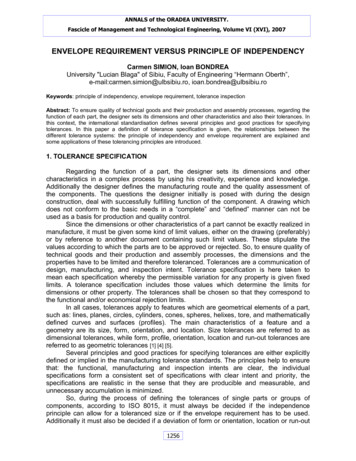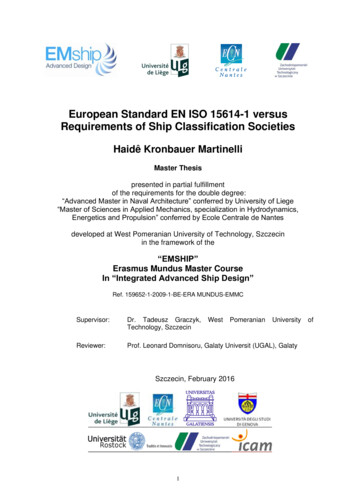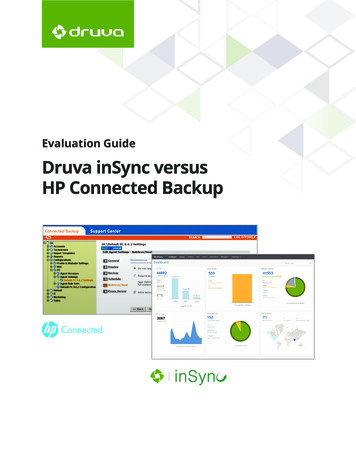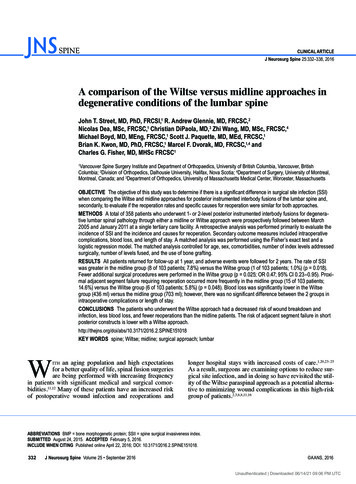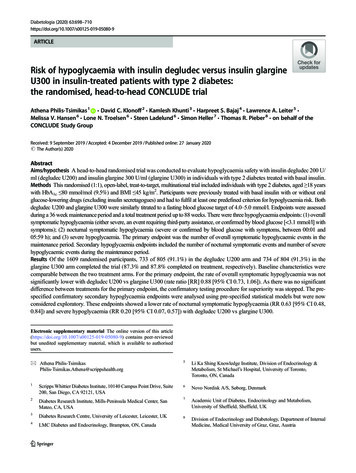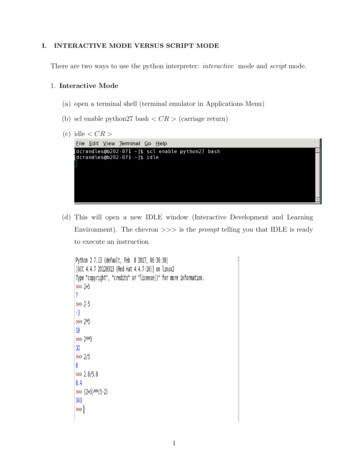
Transcription
I.INTERACTIVE MODE VERSUS SCRIPT MODEThere are two ways to use the python interpreter: interactive mode and script mode.1. Interactive Mode(a) open a terminal shell (terminal emulator in Applications Menu)(b) scl enable python27 bash CR (carriage return)(c) idle CR (d) This will open a new IDLE window (Interactive Development and LearningEnvironment). The chevron is the prompt telling you that IDLE is readyto execute an instruction1
(e) The usual order of operations (PEDMAS) is followed by the ultiplication-Addition-Subraction)i. expressions in parenthesis are evaluated first, followed by the exponentiationoperation.ii. division and multiplication are evaluated next and have the same order.iii. Operations of the same order are evaluated left to right.iv. addition and subtraction have the same order.v. example 3*(2-2) is 0vi. example (2 1)*(4/2) is 6vii. example 3**2 1 is 10 not 27viii. example: 2.0/2.0/2.0 gives the same result as 2.0/(2.0*2.0), that is 0.5ix. the output of 2/5 is zero because python 2 performs floor division and getsrid of digits after the decimal place if the two numbers are both integers.Python 3 will output 0.4 and floor division is performed by a special operator.x. CT RL D exits IDLE2. Script Mode(a) You can also save your commands in a text file, which by convention have thesuffix “.py”, for example, program.py.(b) Create your list of commands inside any text editor, for example gedit. Save thisprogram as “hello.py”.(c) run the program as follows (you have to be sure that you are in the directorywhere the script file “hello.py” is located)2
II.VALUES AND TYPESA value, such as 1,2, 3.14 or ‘Hello World’ is stored in a location in computer memory.The values belong to different types: (i) integer (e.g. 1,2,3), (ii) float (3.14) or (iii) string so called because it contains a “string” of characters (e.g. ‘Hello, World!’). Different typesare stored in different ways in computer memory. The interpreter command “type” can beused to determine type.Open IDLE and enter the commands shown above. Can you explain each python response?Can you explain the syntax error?III.VARIABLESA variable is a name given to a piece of computer memory. One reads theassignment statementx 5.0as meaning “place the float value 5.0 in memory location called x”. One might also say “the3
state of the memory location that we are calling “x” is the float value “5.0” . Recreate thefollowing IDLE conversation where values are assigned to the variables n, e and message :One can see that the variable type is determined by the assignment statement. If yourecreate IDLE conversation belowone will see that the type of a particular variable changes dynamically.IV.VARIABLE NAMES AND KEYWORDSA programmer should strive to use meaningful names that enhance the readability ofa program. Variable Names can be arbitrarily long. They can contain both letters andnumbers and are case-sensitive, but they must begin with a letter. That is ArKiv and arkivare different variable names. To make the names meaningful, consider using underscores forvery long names such as speed of a bullet to improve readability of program. If underscoresare not used, you will get a syntax error . For example, fun fact 100.0 is illegal butfun fact 100.0 is legal.Consider the following IDLE conversation containing three illegal names illustrating that4
variable names must start with a letter, cannot contain illegal symbols (@, etc.) andcannot be one of Python 2’s 31 keywords. The interpreter uses the keywords to recognizethe structure of the program and hence they cannot be used as variable names. in Python3, “exec” is no longer a keyword but “nonlocal” is.The list of python 2 keywords is as inue finally isdefV.forreturnlambda tryCOMMENTSObviously, complicated programs are run in script mode. As programs get larger andmore complicated, they get more difficult to read. It is a good idea to add notes to explainwhat the program is doing, and non-obvious features of the code. This is true if morethan one programmer is working on a project, or if a single programmer is writing a longprogram. It is very often difficult to recall exactly what your program is doing. Calledcomments, these notes start with the ‘#’ symbol. Anything after the comment symbol in aline is ignored by the interpreter.5
6
VI.EXERCISES I1. Start IDLE and type help() to start the online help utility to get information aboutthe print statement.2. Start IDLE and use it as a calculator:(a) to determine the average speed (in km/h) of Sir Roger Bannister who, in 1954,was the first person to run a mile in under four minutes (3 minutes, 58 seconds).(b) to determine the number of seconds in a year.(c) Determine the volume of a sphere 34 πr3 of radius 7 cm. Hint: Using π 3.1416,the value 1077.5688 is wrong.3. Write a program using gedit or another text editor that will print a well-structured English sentence with invalid tokens in it and run it in script mode. (See the introductionfor definition of token)4. Write a program using gedit or another text editor that will print an English sentencewith valid tokens but with an invalid structure and and run it in script mode. (Seethe introduction for definitions of tokens, structure and syntax)5. What is the problem in the following IDLE conversation? Is this a semantic error ora syntax error?6. If you begin an assignment statement with a leading zero, you might get confusingerrors.7
Can you figure out what is going on? Hint: display the values of 01, 010,0100,01000.8
Obviously, complicated programs are run in script mode. As programs get larger and more complicated, they get more difficult to read. It is a good idea to add notes to explain what the program is doing, and non-obvious features of the code. This is true if more than one programmer is working on a project, or if a single programmer is writing a long program. It is very often difficult to recall .


